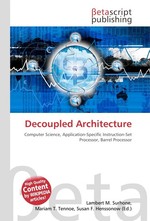Decoupled Architecture
Lambert M. Surhone, Mariam T. Tennoe, Susan F. Henssonow
бумажная книга
Please note that the content of this book primarily consists of articles available from Wikipedia or other free sources online. In computer science a decoupled architecture is a processor with out-of-order execution that separates the fetch and decode stages from the execute stage in a pipelined processor by using a buffer. The buffer's purpose is to partition the memory access and execute functions in a computer program and achieve high-performance by exploiting the fine-grain parallelism between the two. In doing so it effectively hides all memory latency from the processor's perspective. A larger buffer can in theory increase throughput however if the processor has a branch misprediction then the entire buffer may need to be flushed wasting a lot of clock cycles and reducing the effectiveness. Furthermore larger buffers create more heat and use more die space. For this reason processor designers today favour a multi-threaded design approach.
Данное издание не является оригинальным. Книга печатается по технологии принт-он-деманд после получения заказа.


